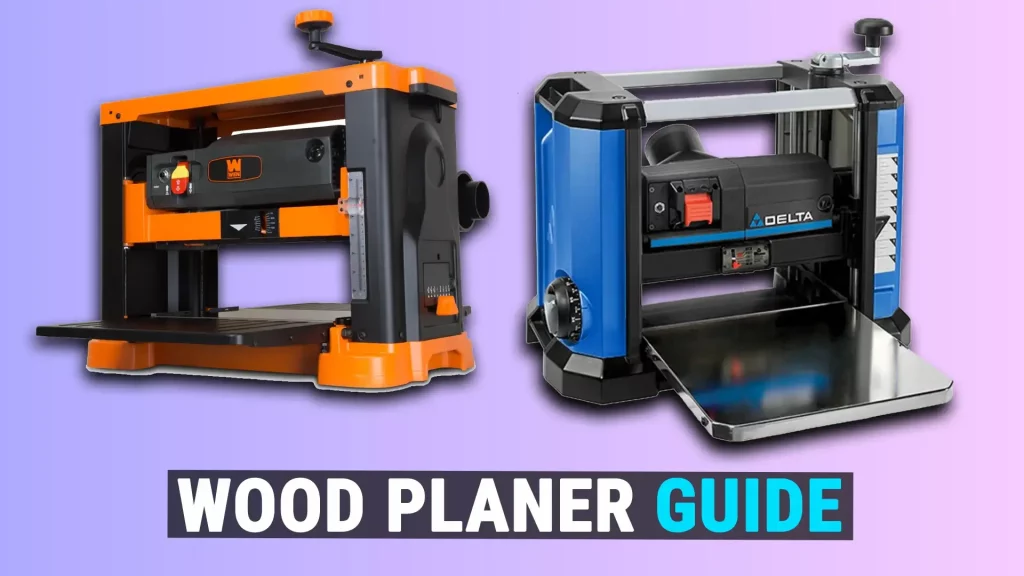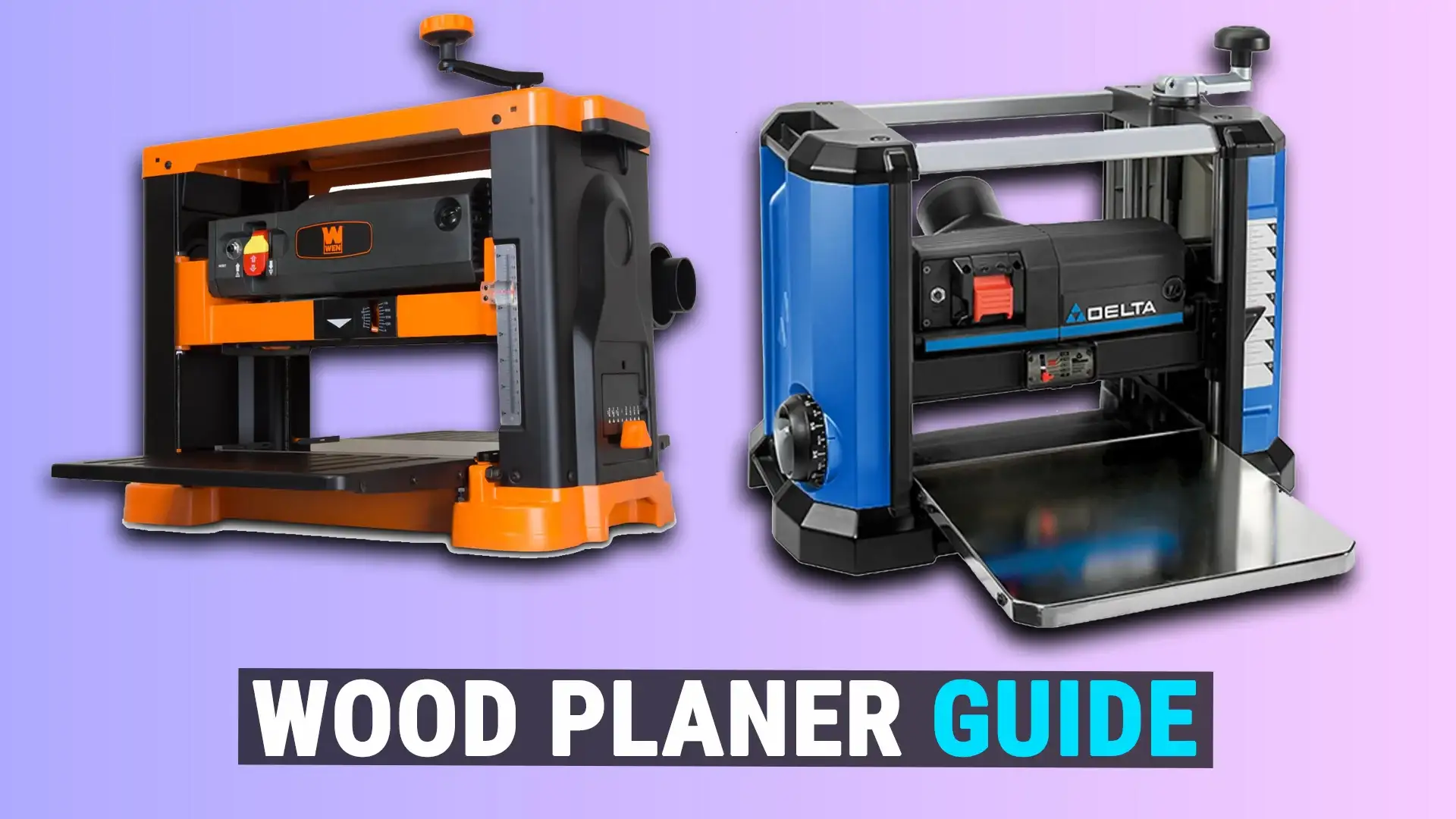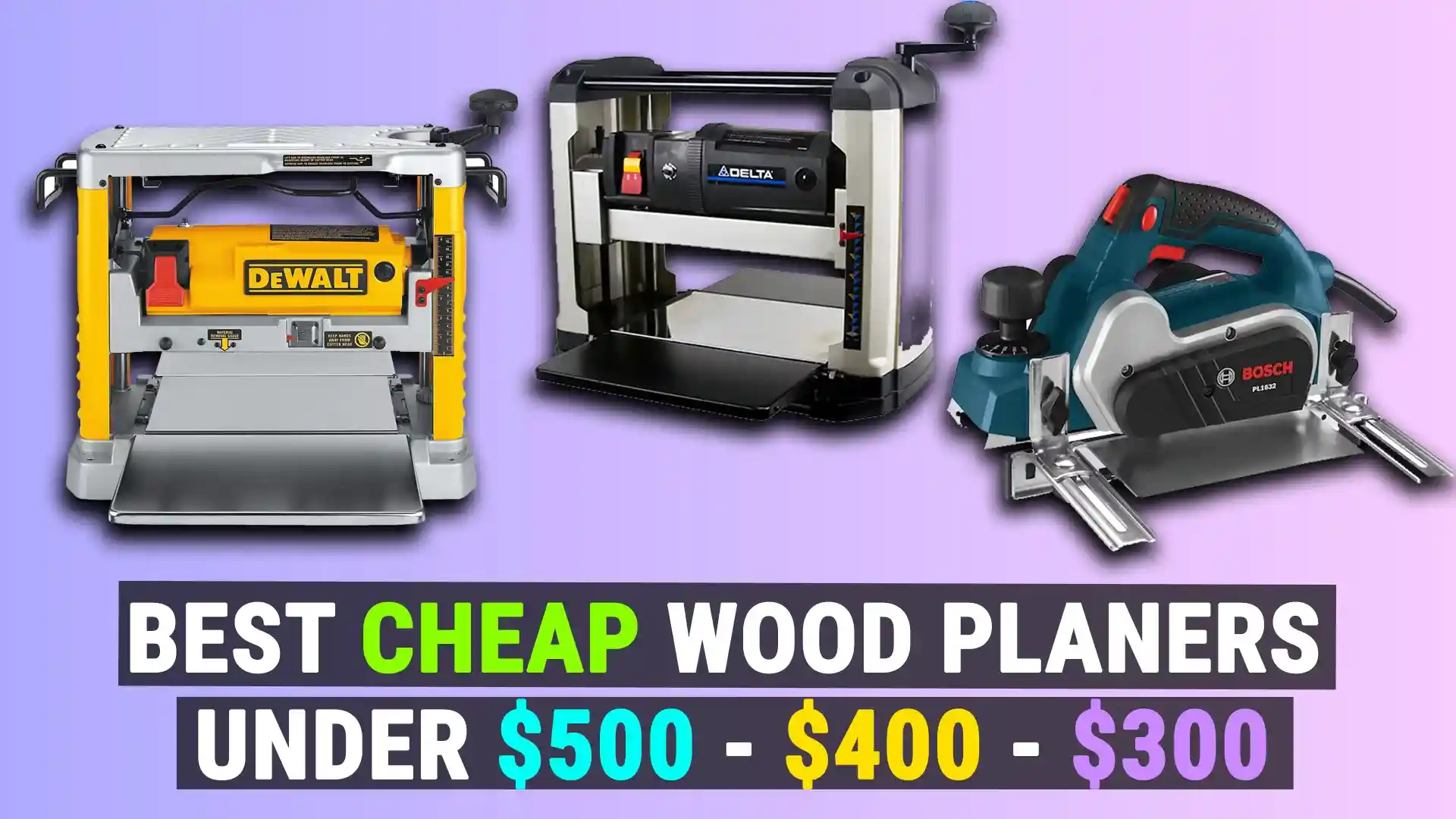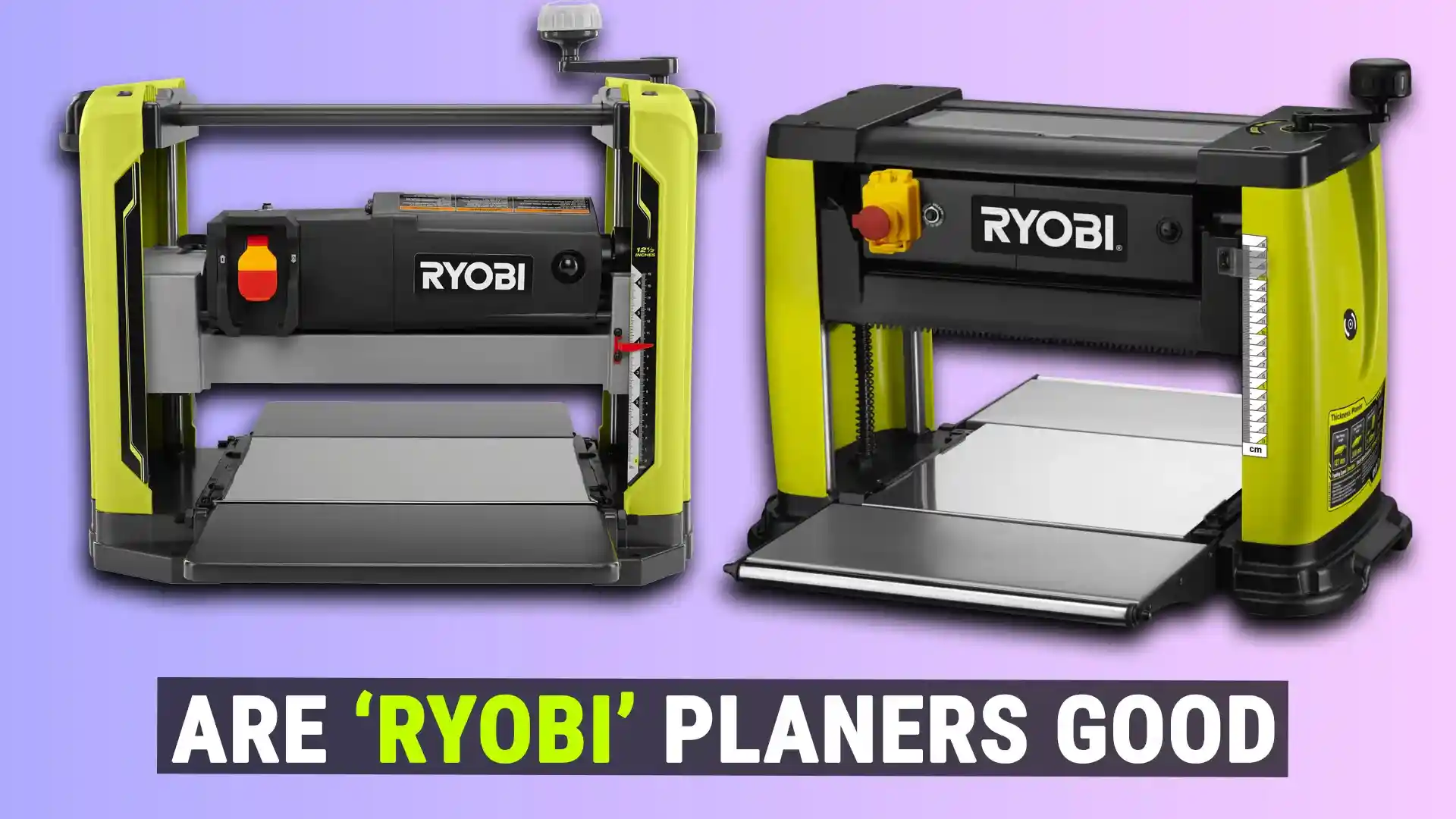Ultimate Wood Planer Guide: Types, Brands, Features, Benefits & Drawbacks
Woodworking planers are essential tools for any serious woodworker.
They provide precision cuts and smooth surfaces to a wide range of projects. But not all planers are created equal, and choosing the right one can be a daunting task.
This article will explore the top woodworking planer brands, their specifications, how they differ from each other, their advantages and disadvantages.
Whether you’re a novice or an experienced woodworker, this guide will help you find the perfect planer for your needs.
We’ll look at the features that set these brands apart – from motor size to depth capacity – so you can make an informed decision.
Plus, we’ll discuss the pros and cons of each brand so you can make sure you’ve got the right one for your project.
No matter what type of woodworking project you have in mind, having the right planer is essential to its success.
With this guide, you’ll be able to find the best tool for your needs in no time!

Definition Of A Planer
A planer is a woodworking tool used to create even and level surfaces.
It works by cutting the wood at different depths and angles. The result is a smooth surface with clean lines.
Planers are commonly used to prepare wood for furniture and cabinetry making, or to flatten out bowed lumber. To understand what a planer does, it helps to look at how it functions.
When the blade of the planer cuts into the wood, it shaves off layers of material until it has reached the desired thickness or depth.
This process allows for precise control over the shape and profile of the workpiece. A good planer can quickly produce an even surface with fine detail and accuracy.
It’s an important piece of equipment in any serious woodworker’s shop.
Types Of Woodworking Planers
When it comes to woodworking, planers are essential tools for creating the perfect surface.
There are several different types of woodworking planers available, and each one has its own advantages and disadvantages. Let’s take a look at some of the most common planer types, their features, and how they can help with your woodworking projects.
Hand Planer
A hand planer is a small handheld tool that is used to flatten rough surfaces on wood pieces.
It has a sharp blade that can be adjusted to cut through even the toughest woods. Hand planes allow for precision control when working on small areas.
Thickness Planer
A thickness planer is designed to quickly reduce the thickness of boards and panels without changing their width or length.
This type of planer can also be used to plane curved surfaces, allowing for intricate details that would otherwise be difficult to achieve with other tools.
Jointer Planer
A jointer planer is a combination of both a jointer and a thickness planer in one machine.
These machines are ideal for larger projects where you need precise cuts in multiple directions. They are often used to plane edges before milling them into shape, as well as making angled cuts and rabbets for joining boards together.
Benchtop Planer
A benchtop planer is smaller than the traditional floor-mounted models and can fit into tight spaces or on relatively small workbenches.
Most benchtop models feature adjustable blades for different cutting depths, as well as dust collection systems so you don’t have to worry about sawdust flying everywhere.
Combination Planers
Combination planers combine several functions in one machine, such as jointing and surfacing capabilities in addition to thicknessing boards and panels.
These tools are great if you need all-in-one functionality but don’t have room for multiple machines in your workshop.
Each type of woodworking planer has its own advantages and disadvantages depending on what type of project you’re working on and what kind of results you’re looking for.
With careful consideration of these factors, you’ll be able to find the right tool for your needs. Now let’s take a look at some popular woodworking planers brands and how they differ from each other.
Popular Woodworking Planer Brands
When it comes to woodworking planers, there are several popular brands on the market. Some of the most widely used planer brands include DeWalt, Makita, and Bosch.
Each of these brands offers a variety of different models and features, so it’s important to do your research before deciding which one is right for you.
Take DeWalt as an example. Their range of woodworking planers includes everything from portable hand planes to heavy-duty benchtop models.
They offer both corded and cordless options that can be used for a variety of projects, from roughing out boards to creating intricate details.
Their versatile machines are also well-reviewed by users across the board for their ease of use and excellent results. Makita also makes some great woodworking planers that have been praised for their durability and precision cuts.
Whether you’re looking for a hand plane or a larger machine with jointing capabilities, they have something to fit any budget or need.
Similarly, Bosch offers a wide range of products that feature advanced technology such as digital readouts and auto-adjusting blades for improved accuracy.
No matter which brand you choose, it’s important to consider what type of project you’ll be working on before making a purchase decision.
Different machines may offer different features depending on their intended uses, so make sure you find one that meets your needs in terms of size, power, and other factors.
With the right woodworking planer in hand, any project will be easier and more enjoyable!
With all that said about various types and brands of woodworking planer machines available in the market today, let us now turn our attention towards an often overlooked factor – Size & Weight considerations when choosing the right woodworking planer for your needs.
Size And Weight Considerations
When selecting a woodworking planer, size and weight are two important factors to consider. The larger the planer, the more cutting depth it can achieve and the heavier it will be.
Table material is also a concern as some materials, such as aluminum, are lighter than others like cast iron.
Weight considerations also depend on how easily you need to move your planer around – if you’re looking for something portable, then a smaller and lighter model might be best.
When it comes to power output, there are three main categories of motor strength: light-duty, medium-duty, and heavy-duty.
Each of these categories has its own range of benefits – for instance, light-duty planers may not have the same power as their heavier counterparts but they are often more affordable and much easier to maneuver.
On the other hand, medium-duty or heavy-duty models tend to offer better performance and durability but come at a higher price tag.
Ultimately it’s up to you to decide which type best suits your needs.
Motor Power Outputs
The motor power output of a woodworking planer is often the most telling factor when it comes to performance.
From light-duty models to heavy-duty monsters, each offers a unique range of benefits and drawbacks. Here’s a look at the various planer motor power outputs and how they compare:
Light-Duty Planers
These small but mighty units can be found in most beginner workshops.
They usually have lower power outputs, making them best suited for smaller projects with thinner material. Their lightweight design makes them easy to move around, and their affordability makes them great for budget-conscious woodworkers.
Medium-Duty Planers
These are the middle ground between light-duty and heavy-duty planers, offering more power than their lighter counterparts while still being relatively affordable.
Medium-duty models allow for larger cutting depths on thicker materials and may also offer more features than their lighter counterparts.
Heavy-Duty Planers
For large projects requiring deep cuts and powerful motors, heavy-duty planers are your best bet. These machines are typically more expensive than their lighter counterparts but offer superior performance and durability in exchange for the higher price tag.
When comparing planer power outputs, it’s important to consider factors such as size and weight as well as motor strength and features.
Depending on your project needs, one type of planer may be better suited than another – it all comes down to personal preference and budget.
With so many options available, there’s sure to be a perfect fit for every woodworker’s shop!
Cutting Depth Capacity
Another important factor when choosing a woodworking planer is the cutting depth capacity.
All planer brands offer varying depths of cut, ranging from shallow to deep. Depending on the type of materials you plan to work with, you may need more or less depth adjustment.
For instance, those working with soft woods may require a shallower depth than those working with hardwoods. Additionally, the size and material of the planer table can also impact its overall cutting depth capacity.
When it comes to maintaining your planer’s cutting depth capacity, there are a few simple steps you can take:
1) Regularly check for loose screws and bolts;
2) Make sure moving parts are properly lubricated;
3) Adjust cutter head height as needed.
Taking these precautions will help ensure that your planer is properly maintained and operating at peak performance levels.
Overall, it’s important to consider both motor power output and cutting depth capacity when selecting a woodworking planer that best fits your needs.
Different brands offer different features and specifications – so make sure to do your research before making a purchase!
Table Size And Material
Now that you are aware of the cutting depth capacity, it is important to consider the table size and material type when selecting a woodworking planer.
The size of the table should be large enough to accommodate the cutting width of the planer and provide adequate support for your materials.
Additionally, the material used for the planer table should be durable and able to withstand frequent use over time. In addition to table size and material, other features like dust collection, infeed rollers, and cutter head speed can also have an impact on your overall planer performance.
Dust collection systems can help keep your workspace clean while infeed rollers ensure your materials are fed through evenly into the cutter head.
Finally, variable speed settings on the cutter head will give you more control over your cutting results. By taking into account all of these considerations – including power output, cutting depth capacity, table size and material – you’ll be sure to find a woodworking planer that best meets your needs!
Features And Accessories
When it comes to features and accessories, there are several factors to consider when selecting a woodworking planer.
Many planers come equipped with dust collection systems, adjustable guides for accuracy, and infeed/outfeed tables for better support of your material.
Some models also feature two-sided blades, allowing you to switch between blades quickly and easily. Finally, many planers offer replaceable knives so you can maintain the sharpness of your blades over time.
These additional features can provide a more efficient and precise cutting experience while also making your workspace cleaner and safer.
With the right accessories, it’s possible to get professional-level results without investing in expensive tools. Overall, having the right features and accessories on your woodworking planer is essential for getting the best performance out of your machine.
With careful consideration of these components, you’ll be able to select a planer that meets all of your needs.
From there, you can move on to comparing price ranges and making an informed decision about which model best suits your budget.
Price Range Comparison
When it comes to woodworking planer prices, there is a wide range of options available. It’s important to consider the features and accessories you need as well as your budget when making a selection.
To help you compare prices, we’ll look at several woodworking planer brands and their price ranges. The first brand to look at is Jet.
Jet offers a variety of models ranging from entry level machines for hobbyists to professional-grade planers for serious woodworkers. Their prices start at around $500 and go up to $2,500 depending on the model and features included.
Next, let’s take a look at DeWalt. DeWalt also offers an extensive range of planers, with prices starting at approximately $200 and going up to around $1,200 for their professional-level models.
Finally, Makita makes some of the most respected woodworking planers on the market today. Their prices range from about $400 to $2,000 depending on features and accessories included in the product.
By comparing these woodworking planer brands side-by-side, you can easily find one that fits within your budget while offering all the features you need for your projects.
With careful consideration of each model’s specifications and price range comparison, you can make an informed decision about which one is right for you.
Now let’s take a closer look at the benefits of owning a planer so that you can determine whether or not it’s worth investing in one.
Benefits Of Owning A Planer
Having looked at the various woodworking planer brands and their respective price ranges, it is now time to consider the benefits of owning one.
A planer can provide woodworkers with a number of advantages when it comes to accuracy, efficiency, and surface finish. Here are some of the key benefits:
Accuracy:
- Increased accuracy in cutting and shaping wood
- Accurate measurements for precise cuts
- Improved ability to follow detailed plans and designs
Smoother Surfaces:
- Reduced sanding time for smoother surfaces
- Ability to create consistent thicknesses for better finish
- Ability to remove splinters and rough edges more quickly
Reducing Waste:
- Reduced waste from inaccurate cuts or inconsistent thicknesses
- Cost savings from not having to buy additional materials due to mistakes or errors in measurement.
With these advantages in mind, owning a planer can be a valuable investment for any woodworker looking for improved accuracy, smoother surfaces, and reduced waste.
It’s important, however, to understand the drawbacks of using a planer before making your final decision.
Drawbacks Of Owning A Planer
Owning a planer may seem like the ultimate solution for any woodworking project, but there are certain drawbacks that should be taken into account.
For starters, planers can be incredibly noisy machines, creating a significant amount of noise pollution in the workshop.
Additionally, dust control is often an issue with planers and extra measures must be taken to ensure that this does not become a problem.
Furthermore, blade maintenance is essential and requires regular sharpening or replacement of blades to ensure accurate results.
Safety hazards are also an issue when it comes to planers; operators must take all necessary precautions while operating these powerful machines.
Finally, small workpieces can often be difficult to manage on a planer, meaning additional machining steps may be required.
Overall, while owning a planer has many advantages for woodworkers, these potential drawbacks should still be considered before making the purchase.
With all these factors in mind, it is important to keep up-to-date with maintenance recommendations to get the best out of your investment.
Maintenance Recommendations
To ensure the longevity and efficiency of your planer, it is important to follow proper maintenance recommendations.
Planer maintenance includes blade sharpening or replacement, dust collection, and machine lubrication. Regularly sharpening the blades will help to keep them in top condition and ensure accurate cuts on workpieces.
Dust collection is also essential for a clean workspace, as well as for health reasons; it’s recommended that you use a dust collection system with your planer.
Finally, machine lubrication should be carried out regularly to reduce wear and tear on the internal components of the machine.
By following these basic maintenance recommendations, you can get the best performance out of your planer while keeping it in good condition for longer.
Proper care and upkeep requires planning and effort but is essential in order to maximize the benefits of owning a planer.
Conclusion
In conclusion, owning a planer is an invaluable tool for any woodworker. It can help create beautiful projects that are sure to turn heads.
With so many woodworking planer brands on the market, finding the right one to fit your needs can be daunting.
However, by considering the size and weight requirements, motor power outputs, price range, and the benefits and drawbacks of owning a planer, you can make an informed decision about which one will best suit your needs.
Using a planer can be a real joy. The sound of the motor creating smooth surfaces from lumber can be quite gratifying and calming.
Watching as each board is transformed into something beautiful and functional is an experience that every woodworker should take part in.
With a little bit of maintenance here and there, your planer should last you for years to come – giving you plenty of opportunities to get creative with your projects!
Discover the must-have features of Ace Hardware wood planers for 2024 in this detailed guide!




